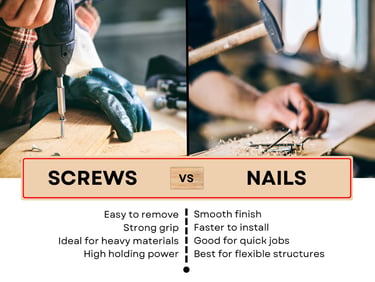Screws vs. Nails: Which One is Better for Your Project?
Nails or screws? Learn the key differences, strengths, and best applications for each fastener to choose the right one for your construction project.


Introduction
When it comes to construction, woodworking, and DIY projects, choosing between screws and nails can impact the strength, durability, and efficiency of your work. Both fasteners have their strengths and weaknesses, and understanding their differences will help you select the best option for your specific project.
Strengths and Weaknesses of Screws
Strengths:
Superior holding power: Screws have threads that grip materials tightly, reducing the chance of loosening over time.
Better load-bearing capacity: Ideal for applications requiring strong structural integrity.
Ease of removal and adjustment: Can be easily unscrewed for repairs or modifications.
Reduced splitting in wood: Pre-drilling can help prevent material damage.
Weaknesses:
Slower installation: Requires a drill or screwdriver, increasing labor time compared to nails.
Brittle under shear force: Can snap under lateral movement or sudden impact.
More expensive: Generally cost more per unit than nails.
Strengths and Weaknesses of Nails
Strengths:
Faster installation: Can be quickly driven into materials using a hammer or nail gun.
Better flexibility: Can withstand shear forces without breaking, making them ideal for framing and structural applications.
More affordable: Cost-effective for large-scale projects.
Weaknesses:
Lower holding strength: Nails may loosen over time, especially with movement or vibration.
Difficult to remove without damage: Removing nails can cause material damage or leave holes.
Limited adjustability: Once driven in, nails cannot be easily adjusted.
Ideal Use Cases for Screws
Screws are best suited for:
Decking and outdoor structures: Provides strong grip and durability against weather conditions.
Furniture and cabinetry: Prevents loosening over time with daily use.
Drywall installation: Ensures a firm hold without damaging the material.
Metal-to-wood connections: Self-tapping screws provide strong bonds in mixed-material applications.
Ideal Use Cases for Nails
Nails are preferred for:
Framing and structural work: Withstands lateral movement and impacts.
Roofing and siding: Nail guns speed up installation and hold materials in place efficiently.
Hardwood flooring: Nails penetrate deep without causing excessive splitting.
Temporary fixtures: When quick installation and easy removal are needed.
Choosing the Right Fastener for Your Project
When deciding between screws and nails, consider:
Load requirements: Screws for high holding power; nails for shear strength.
Installation speed: Nails for faster work; screws for precision.
Material type: Softwood vs. hardwood, metal, drywall, or concrete.
Long-term durability: Screws for resistance against loosening; nails for flexibility under stress.
Conclusion
Both screws and nails have their place in construction and DIY projects. Understanding their strengths and best applications will help ensure the success of your project. For expert advice and high-quality fasteners, explore Bait Alnuhas’s selection of premium screws and nails designed for durability and reliability.
